Artículos SCI
2020
2020
Tribología y Protección de Superficies
Tribomechanical properties of hard Cr-doped DLC coatings deposited by low-frequency HiPIMS
Santiago, JA; Fernandez-Martinez, I; Sanchez-Lopez, JC; Rojas, TC; Wennberg, A; Bellido-Gonzalez, V; Molina-Aldareguia, JM; Monclus, MA; Gonzalez-Arrabal, RSurface & Coatings Technology, 382 (2020) 124899
Show abstract ▽
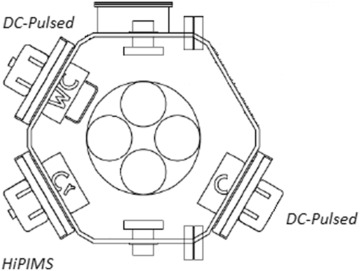
Cr-doped diamond-like carbon (Cr-DLC) films with Cr contents ranging from 3 up to 20 at. % were synthesised in a codeposition process with HiPIMS (Cr deposition) and DC-pulsed technology (C deposition). The application of HiPIMS at low frequencies was observed to significantly enhance the energy density during the Cr plasma discharge due to the interaction of Cr-C species. The higher energy bombardment at low HiPIMS frequencies allowed doping with Cr the DLC structure avoiding the graphitization of the carbon structure. EELS spectroscopy was used to evaluate sp(3) content and Raman was used for sp(2) structural characterization of the films. Enhanced mechanical properties (hardness up to 30 GPa) were observed with nanoindentation for Cr-doped DLC at low frequencies. High temperature nanoindentation tests were also performed from room temperature to 425 degrees C in order to evaluate the evolution of hardness and Young Modulus with temperature. The results showed that the mechanical properties at high temperature mainly depend on the initial sp(3)-sp(2) structure. Tribological tests were carried out in air from room temperature to 250 degrees C. Cr-doped DLC coatings deposited by low-frequency HiPIMS showed lower friction and wear compared to undoped DLC.
Enero, 2020 | DOI: 10.1016/j.surfcoat.2019.124899
2019
2019
Materiales de Diseño para la Energía y Medioambiente
Understanding segregation processes in SAMs formed by mixtures of hydroxylated and non-hydroxylated fatty acids
Bueno, OVM; Benitez, JJ; San-Miguel, MARSC Advances, 9 (2019) 39252-39263
Show abstract ▽
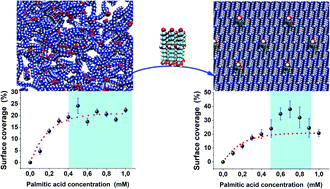
In this paper, we focus on the segregation processes emerging when preparing mixtures with different compositions of aleuritic (9,10,16 trihydroxyhexadecanoic) (ALE) and palmitic (hexadecanoic) (PAL) acids. The combination of atomic force microscopy (AFM) and molecular dynamics (MD) simulations enabled us to prove the role of the functional groups in the formation of self-assembled monolayers (SAMs) on muscovite mica surfaces. MD simulations indicate that segregation processes are favored in high ALE composition mixtures in agreement with the experimental evidence, whereas low ALE compositions promote the co-existence between segregated and dispersed systems. The secondary hydroxyl groups play a central role in the self-assembling mechanism because they control the formation of hydrogen bonding networks guarantying system stability.
Diciembre, 2019 | DOI: 10.1039/c9ra06799j
Reactividad de Sólidos
Low temperature synthesis of an equiatomic (TiZrHfVNb)C5 high entropy carbide by a mechanically-induced carbon diffusion route
Chicardi, E; Garcia-Garrido, C; Gotor, FJCeramics International, 45 (2019) 21858-21863
Show abstract ▽
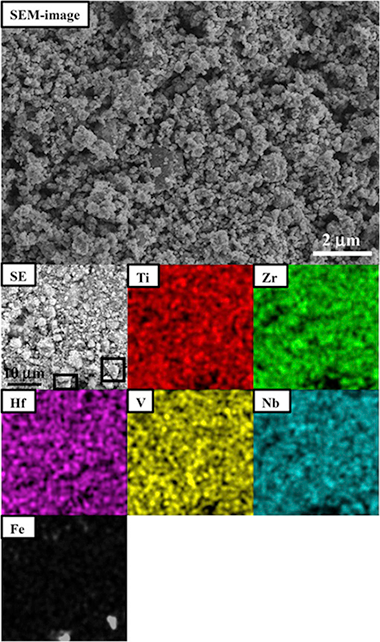
A novel, homogeneous, nanostructured and equiatomic (TiZrHfVNb)C-5 High Entropy Carbide (HEC) was successfully synthesised in a powder form by a mechanosynthesis process from the elemental mixture. This synthesis method for HECs, not previously reported, is simple, reproducible and carried out at room temperature. During milling, the transition metals (Ti, Zr, Hf, V and Nb) alloying and the diffusion of carbon (introduced as graphite) into the alloy structure are simultaneously induced, obtaining the expected (TiZrHfVNb)C-5 HEC. The room temperature method employed contrasts with those reported in the bibliography from binary carbides that are carried out at a very high temperature (1800-2200 degrees C), with the consequent energy savings.
Diciembre, 2019 | DOI: 10.1016/j.ceramint.2019.07.195
Nanotecnología en Superficies y Plasma
Graphene Formation Mechanism by the Electrochemical Promotion of a Ni Catalyst
Espinos, JP; Rico, VJ; Gonzalez-Cobos, J; Sanchez-Valencia, JR; Perez-Dieste, V; Escudero, C; de Lucas-Consuegra, A; Gonzalez-Elipe, ARACS Catalysis, 9 (2019) 11447-11454
Show abstract ▽
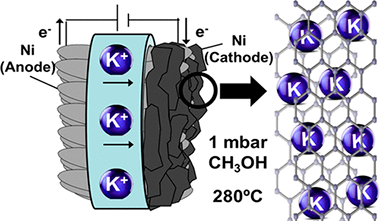
In this work, we show that multilayer graphene forms by methanol decomposition at 280 degrees C on an electrochemically promoted nickel catalyst film supported on a K-beta Al2O3 solid electrolyte. In operando near ambient pressure photoemission spectroscopy and electrochemical measurements have shown that polarizing negatively the Ni electrode induces the electrochemical reduction and migration of potassium to the nickel surface. This elemental potassium promotes the catalytic decomposition of methanol into graphene and also stabilizes the graphene formed via diffusion and direct K-C interaction. Experiments reveal that adsorbed methoxy radicals are intermediate species in this process and that, once formed, multilayer graphene remains stable after electrochemical oxidation and back migration of potassium to the solid electrolyte upon positive polarization. The reversible diffusion of ca. 100 equivalent monolayers of potassium through the carbon layers and the unprecedented low-temperature formation of graphene and other carbon forms are mechanistic pathways of high potential impact for applications where mild synthesis and operation conditions are required.
Diciembre, 2019 | DOI: 10.1021/acscatal.9b03820
Nanotecnología en Superficies y Plasma
Hydrophobic and Icephobic Behaviour of Polyurethane-Based Nanocomposite Coatings
Przybyszewski, B; Boczkowska, A; Kozera, R; Mora, J; Garcia, P; Aguero, A; Borras, ACoatings, 9 (2019) 811
Show abstract ▽
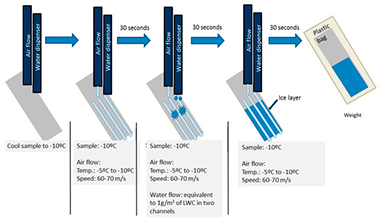
In this paper, hydrophobic nanocomposite coatings based on polyurethane (PUR) modified by nano-silica and silane-based compounds were manufactured by spraying. The main challenge was to assess and improve the hydrophobic as well as anti-icing properties of initially hydrophilic polymer coatings. The prepared nanocomposite coatings were characterized by means of scanning electron microscopy (SEM), optical profilometry and X-ray photoelectron spectroscopy (XPS). The results obtained showed that in order to achieve hydrophobicity, appropriate amounts of nano-silica must be incorporated in the coating, and complete coverage by nano-silica particles is necessary for achieving hydrophobicity. Coating adhesion and the durability of the hydrophobic behaviour were also studied by scratch test and frosting/defrosting cycles, respectively. The results show that use of both nano-silica and silane-based compounds improve the hydrophobic and anti-icing properties of the coating as compared to a non-modified PUR topcoat. A synergistic effect of both additives was observed. It was also found that the anti-icing behaviour does not necessarily correlate with surface roughness and the materials' wetting properties.
Diciembre, 2019 | DOI: 10.3390/coatings9120811
- ‹ anterior
- 110 of 410
- siguiente ›














